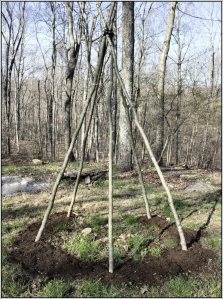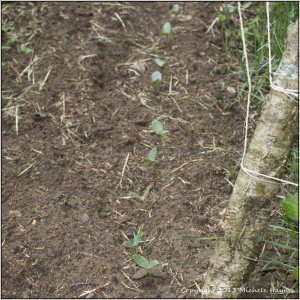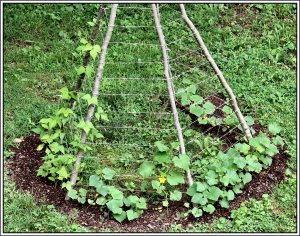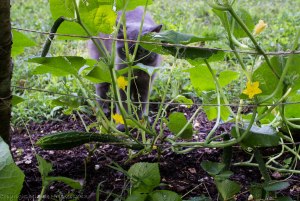Wednesday, July 24
Another rainy night last night. I am spared watering and everything seems to be doing so much better with rainwater vs. well water. No surprise there.

Moskovich tomato ripening
I finally have my first ripening tomato in spite of temperatures upwards of 89° F yesterday.
Squash are continuing to produce small numbers. Seriously, I can’t believe how few squash I have this year so far, though I am grateful for the ones we have eaten. They are so good, and my 20 year old even put zucchini in the spaghetti sauce the other night for an extra layer of flavor.

First marigold flower, Naughty Marietta, an heirloom — it is a day of firsts around here
I pulled up three pumpkin plants yesterday and found the vines that I left in the ground are still alive this morning. Pumpkins put out roots along the way to support their long vines. I think I’ll just pull up the rest of the mother plants and the vines that survive on their own will be a bonus. Nothing lost if they don’t produce any pumpkins, and maybe I will be surprised with a couple of small sugar pumpkins in the fall.
Added another level of twine installed on the front garden tomato supports. Plants are loaded with Yellow Pear tomatoes but still no plum tomatoes on the other six plants. They must be a late-season tomato. I grew these plants from seeds that I saved from a tomato purchased at a farmer’s market. Although the vendor assured me that it was an heirloom variety, there are no guarantees. These tomato plants are one of my experiments.
I spent some time in my favorite yarn shop, Connecticut Yarn & Wool in Haddam, yesterday talking with Carol about preserving food. She shared some techniques that she uses to preserve tomatoes and kale. I was inspired to plant more kale so I can preserve it for the winter. Kale seeds sowed in the pumpkin bed (where the pumpkin plants no longer reside).

First eggplant flower
My son’s roommate got the chainsaw running just long enough to take down two small trees, allowing a little more light into my front garden. Then said chainsaw stopped working again (leaving us with two felled trees that need to be cut up into log lengths, one well into the front yard). I am going to look into a hand saw. We have discovered the hard way that it is well worth spending what seems like an unreasonable amount of money to buy good quality tools. My son purchased a Stihl felling axe that is amazing. It cuts into trees like nothing I’ve ever seen. But it takes real muscle to wield. The chain saw is more predictable for taking down a tree and having it land where you want it to land (missing people, houses, trees that you want to keep and power lines). The dream is a Stihl chain saw. Dreaming is good, right?
Thursday, July 25
Brrrr . . . it is a little chilly today. 57° F at 6:30 a.m. Watered seeds and seedlings, cucumbers and tomato plants in grow bags. Zucchini has germinated in the squash bed. More buckwheat is popping up in the garlic bed. More tomatoes have begun to turn red, promising fresh salsa possibly within a week.
Friday, July 26
Another rainy day. It rained all night. Glad that my raised beds have well-draining soil. Started fermenting some pickles in Fido jars. First time ever making pickles, though I did ferment green beans, carrots, garlic and onions last fall which were absolutely delicious.
Saturday, July 27

Strawberry popcorn tassels
Quick walk around, harvested some cucumbers, one zucchini and one yellow squash. Saw that the dill is up in the pumpkin bed (that I sowed over about 10 days ago), zucchini seeds germinated where I just put them here and there, and one area of buckwheat has germinated and another seems to not be. I will resow buckwheat in the area showing failure. I wonder if some creature came and ate the seeds.
Three tomatoes ripening now, and soon I will have more tomatoes than I will know what to do with. I plan to can salsa for the winter. We love salsa on everything and because most commercial salsas contain vinegar (which is made from genetically modified corn), we have been doing without.
But look what I found in the Strawberry popcorn patch. Tassels are emerging from the largest of the popcorn plants. So excited! Reading up on tasseling, I think I will be okay, but I will probably go out and see if I can help the pollinating process along a little bit when it is time. Each kernel of popcorn (or corn) must be pollinated separately.
Started two more jars of pickles. I am using lacto-fermentation in a closed environment, not canning using a water bath.
Sunday, July 28
It is comfortably cool outside (meaning I could wear a sleeveless shirt and flip flops with no discomfort) while puttering around in the garden this morning. I watered the cucumbers and grow bag tomatoes. Everything else was moist enough.
Harvested some more cucumbers and saw a lot of new cukes forming. I read that Suyo Long cucumbers are one of the slicing cucumbers that can be used for pickling. Yay! Great news for my pickle loving son.

Front garden: pickling cucumbers growing on a pear branch trellis with 12 tomato plants supported by two more trellises and twine
My front garden tomato plants are full of cherry tomatoes, the yellow pear variety and another variety that I cannot identify yet. And the plum tomatoes are beginning to set fruit, finally. The positive side to slower tomato formation is that I will be harvesting tomatoes next month and possibly into September. Fresh tomatoes in September? Oh yeah!
Kale seeds have germinated in pumpkin bed. Lots and lots of tiny kale plants. I think every single seed has germinated. I will be thinning some of these plants, probably moving the extras to other areas. I want to dehydrate a lot of kale before it gets cold for putting in soups during the cold months.
Monday, July 29

Suyo Long cucumbers growing inside the teepee trellis.
Humidity is the word to describe this day. But it wasn’t hot yet when I watered my entire garden. Although everything looked moist on the surface because of heavy dew, when I put my finger several inches down into the soil, it was dry. So I watered deeply today hoping that I can skip a day or two per waterings and get back on my staggered schedule of half one day and half the next with grow bags getting water every day.
Lots of new cucumbers on vines in front and back gardens. I am allowing several cucumbers to remain on the vine to ripen for seed collection in the fall. The cucumbers I have been harvesting lately are smaller than the early cucumbers, so I think it is time for another application of compost this week.
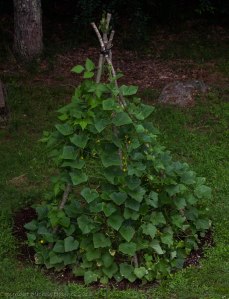
Teepee trellis a compact way to grow a lot of cucumbers in a fairly small space
I am thrilled with the teepee trellis I devised for growing cucumbers this year. Although one side was sowed with Romano green beans, I have yet to see one flower and, subsequently, no beans. The cucumber vines, on the other hand, absolutely love the teepee trellis and are spreading to the bean side now; I am happy to give them the space. I think I will create a post dedicated to how I created what I have been calling the “bean teepee,” that turned out to be a cucumber teepee.
Brassicas are a huge challenge to grow organically. Even organic gardeners spray Bt to control caterpillar damage, and I am thinking about doing the same. I survived the earlier attack by Cabbage White moth larvae (caterpillars) only to have a new attack by two different caterpillars that I have yet to identify. Yes, I squished a lot of caterpillars today. I did end up spraying my cabbages with my homemade peppermint spray that I use as mosquito and tick repellant near the end of the last attack, and I might just do that again.

San Marzano plum tomatoes
More tomatoes ripening. I have three Moskovich tomatoes I picked already ripening indoors (because Moskovich tend to split if left on the vine too long). More new tomatoes growing in front garden. Harvested another yellow squash. Snow pea vines are starting to produce again but since it is only a few pods per day I typically eat them while puttering around in the garden.
I pulled up most of the coriander (cilantro) since most of the seed pods were dried, or partially dried.
Tuesday, July 30

Multiple female flowers on cucumber vines
I did my morning rounds before 6 a.m. and it was delightful. Cool and quiet, it is like the day is holding its breath to see what will happen next.
I harvested a bunch of ground cherries, one plum tomato and two Suyo Long cucumbers. Then I noticed the cucumber vines in the back yard. They are covered with tiny, new female flowers and potential cucumbers. August looks like it might be a good month for cucumbers and pickle making.

Finally, a sugar pumpkin
Oh, how I could not exclaim this first before anything else, I don’t know. But it looks like I have 3 sugar pumpkins truly growing after all of this time. What have I done differently? I started watering the ends of the vines, not the base. After pulling up all eight of the pumpkin plants from the raised bed and just dumping them on the ground, I started watering the last 6-8 feet of each vine whenever I water my garden. Looks like that is what was necessary for the pumpkins to “take” and then survive. I can only hope there is enough time for some of these babies to mature before it freezes. I am thinking about making the back yard my pumpkin patch which would mean piling leaves, manure, and whatever else I can find on the ground to kill the grass and make that ground fertile over the winter. I just need to avoid the opening to the septic tank and I should be okay. Then next year I would have the area prepared for growing pumpkins.
I will leave you with a photo of black bean pods. I discovered that black bean pods turn purple as they mature.

Purple black bean pods? Interesting.
Hope everyone is having a great week. Happy gardening!

